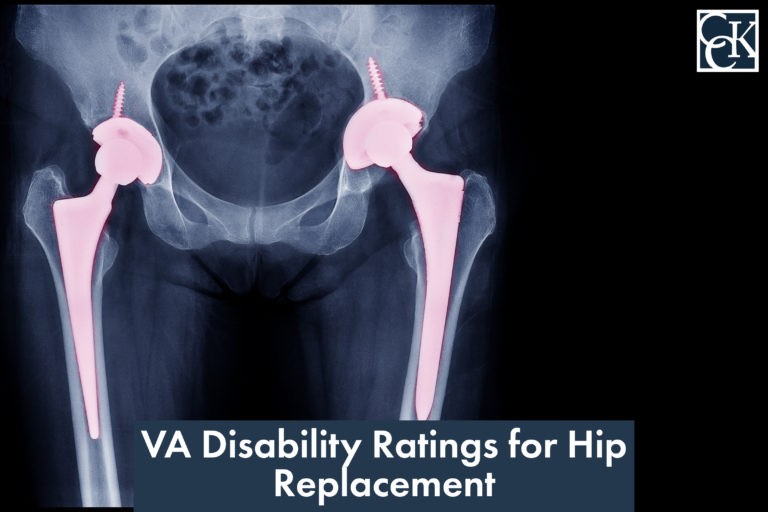VA Disability Ratings for Hip Replacement

CCK Law: Our Vital Role in Veterans Law
Hip Conditions and Hip Replacement
VA rates joint problems based on specific criteria and measurements of the range of motion in that joint, including hip replacement. Generally speaking, for a veteran to receive a disability rating for their joint condition their limited range motion in a joint must be documented in their medical records or treatment notes or must fall under specific criteria outlined under particular diagnostic codes.
The hip is one of the most common joints with which veterans experience complications and for which they receive disability benefits. For example, many veterans have osteoarthritis in their hips.
Osteoarthritis of the Hips
Osteoarthritis occurs when the cartilage in a person’s joint breaks down and mostly impacts weight-bearing joints. This can be very painful because the breakdown of such cartilage can cause bones to rub together.
Osteoarthritis of the hip is so common among veterans in part due to the rigorous training and physical demands of active duty, including frequently carrying heavy gear for long periods of time. This can put pressure on a veteran’s hip joints and eventually cause osteoarthritis.
There is currently no known cure for osteoarthritis. Consequently, it is managed with a variety of treatments to reduce disability, improve function, and alleviate symptoms. However, if the veteran’s osteoarthritis is severe, surgical intervention may be necessary. The most effective surgical option for severe osteoarthritis of the hip is a total joint replacement (hip replacement).
How Does VA Rate Hip Replacement?
VA rates hip replacements under 38 CFR § 4.71a, Schedule of Ratings – Musculoskeletal System, Diagnostic Code 5054 as follows:
- 100% – for four months following implantation of prosthesis or resurfacing
- 90% – following implantation of prosthesis with painful motion or weakness such as to require the use of crutches
- 70% – markedly severe residual weakness, pain or limitation of motion following implantation of prosthesis
- 50% – moderately severe residuals of weakness, pain or limitation of motion
- 30% – minimum rating, total replacement only
After the 100 percent rating period has concluded, the veteran will be evaluated again for hip resurfacing under diagnostic codes 5250 through 5256.

Hip replacement at a Non-VA Hospital
Veterans often undergo hip replacement surgery at a VA Medical Center; however, some veterans may choose to go to a private, non-VA hospital for the procedure. If this is the case, veterans must inform VA of the hip replacement surgery as soon as possible. If they wait until after one year following the surgery to inform VA, then the veteran is no longer eligible for the 100 percent disability rating.
Recovering from Hip Replacement Surgery
Whether you are recovering at home or in a rehabilitation facility, it is important to take precautions for your hip. Be sure to see your surgeon for scheduled follow-up visits, and return to activity slowly. Post-operative visits will allow your surgeon to make sure your hip is healing properly. If you experience any of the following symptoms following hip replacement surgery, you may want to contact your surgeon:
- An increase in hip pain
- Pain or swelling in a calf or leg
- Unusual redness, heat, or drainage at the incision site
- Trouble breathing or chest pains
- Fever over 100 degrees Fahrenheit
To check hip joint stability over time, you may be scheduled for X-rays every year or two.
About the Author
Share this Post
